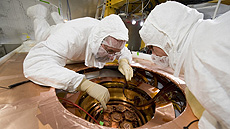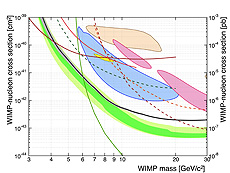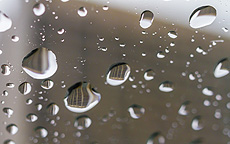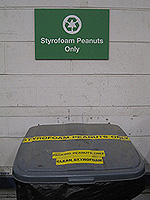|
Monday, March 3
- Breakfast: blueberry pancakes
- Breakfast: sausage, egg and cheese croissant
- Sloppy joe
- Smart cuisine: teriyaki pork stir fry
- Chicken curry
- Italian antipasto panino
- Italian pasta bar
- Vegetarian cream of spinach
- Texas-style chili
- Assorted pizza by the slice
Wilson Hall Cafe menu
|
|
Wednesday, March 5
Lunch
Menu unavailable
Friday, March 7
Dinner
Menu unavailable
Chez Leon menu
Call x3524 to make your reservation.
|
|
Tornado drill tomorrow, part of Severe Weather Preparedness Week
Tomorrow at 10 a.m., Fermilab will conduct a tornado drill along with a test of the Sitewide Emergency Warning System. These activities coincide with the Severe Weather Preparedness Week, which the National Weather
Service declared to be the week of March 2.
All areas of the laboratory should participate in the drill by either proceeding to the nearest tornado shelter or conducting a tabletop discussion. It is up to the discretion of division, section or center management as to which option is exercised.
This is also an opportunity — at home or in the workplace — to review and remind yourself of local tornado procedures and to practice reacting to tornado alarms by moving to and occupying designated tornado shelters. Additional information can be found at the Business Services Section Emergency Management Web page under the Severe Weather section.
|
CDMS result covers new ground in search for dark matter
 |
The Cryogenic Dark Matter Experiment has set more stringent limits on light dark matter.Photo: Reidar Hahn
|
Scientists looking for dark matter face a serious challenge: No one knows what dark matter particles look like. So their search covers a wide range of possible traits — different masses, different probabilities of interacting with regular matter.
On Friday, Feb. 28, scientists on the Cryogenic Dark Matter Search experiment, or CDMS, announced they have shifted the border of this search down to a dark-matter particle mass and rate of interaction that has never been probed.
"We're pushing CDMS to as low mass as we can," says Fermilab physicist Dan Bauer, the project manager for CDMS. "We're proving the particle detector technology here."
Their result, which does not claim any hints of dark matter particles, contradicts a result announced in January by another dark matter experiment, CoGeNT, which uses particle detectors made of germanium, the same material as used by CDMS.
To search for dark matter, CDMS scientists cool their detectors to very low temperatures in order to detect the very small energies deposited by the collisions of dark matter particles with the germanium. They operate their detectors half of a mile underground in a former iron ore mine in northern Minnesota. The mine provides shielding from cosmic rays that could clutter the detector as it waits for passing dark matter particles.
Friday's result carves out interesting new dark matter territory for masses below 6 billion electronvolts. The dark matter experiment Large Underground Xenon, or LUX, recently ruled out a wide range of masses and interaction rates above that with the announcement of its first result in October 2013.
Read more
View the arXiv paper
—Kathryn Jepsen
The Fermilab scientists who contributed to this result are Dan Bauer, Don Holmgren, Lauren Hsu and Ben Loer, aided by resident student Ritoban Basu Thakur from the University of Illinois at Urbana-Champaign.
 |
The solid black curve shows the upper limit on the rate of WIMP interactions with normal matter versus WIMP mass from this result. For further details, view the arXiv paper. Image: CDMS
|
|
Watery windows to Wilson Hall
 |
| Different perspectives of Wilson Hall can be seen through a water-droplet-sprinkled car window. Photo: Elliott McCrory, AD |
|
Rajendran Raja, 1948-2014
From Chicago Tribune, Feb. 27, 2014
Rajendran Raja, an Indian-born physicist who was educated in England and came to the United States in the1970s to work as a physicist at Fermilab near Batavia, is considered a driving force in some of the more significant discoveries in physics over the past two decades.
Mr. Raja, 65, a former senior scientist at Fermilab, died Saturday, Feb. 15, in his Naperville home. He had continued his research for more than a year after being diagnosed with a brain tumor in 2011 but stopped working in October 2013.
Read more
|
Fresh hint of dark matter seen in neutrino search
From New Scientist, Feb. 25, 2014
Flashes of X-rays from crowded galaxy clusters could be the long-awaited sign that we have found particles of dark matter — the elusive substance thought to make up the bulk of all matter in the universe.
If the results stand up, dark matter would consist of ghostly particles called "sterile" neutrinos. These tantalising particles would be the first kind found beyond the standard set known to science.
Read more
|
|
How can I recycle? Let me count the ways
 |
| The Accelerator Division collects styrofoam peanuts in the Cross Gallery high bay for the Shipping Department to reuse. The Shipping Department can reuse almost all kinds of packing material. Before you throw something in the trash or recycling bins, consider if the items could be used elsewhere in the lab. Photo: Katie Kosirog, ESH&Q
|
We've all heard the phrase "reduce, reuse, recycle." Reducing waste is the best option of the three: Purchasing only what you really need means using less resources. Reusing items saves them from being tossed in a landfill, where they are no longer useful to anyone for any purpose.
Recycling is perhaps the easiest alternative to throwing something in the trash. But with many more items that are able to be recycled than before, recycling rules can be hard to follow. What do I do with plastic packaging? Why can't I put an item with the no. 6 recycle symbol in the recycling bin? And where do I take these items?
One of the goals in Fermilab's Site Sustainability Plan is to divert at least 50 percent of nonhazardous solid waste by FY2015. Fermilab exceeds this goal, recycling about 75 percent of waste created annually.
But there is always room for improvement. We can all play a part in reducing what goes into a landfill, both at work and at home.
At Fermilab, most everything that can be recycled is recycled. If you have questions about the recyclability of certain items (such as VCR tapes, which can be recycled through our electronics recycling vendor), call your waste coordinator or environmental officer or the appropriate contact:
- Paper, cardboard, plastic (not no. 6 plastic), bottles, cans and other desk-side recycling: Janitorial, x2798
- Styrofoam (clean no. 6 white packaging foam only): Transportation, x3132
- Styrofoam peanuts and other packing material: Shipping, x3171
- Scrap metal, electronics, printer cartridges and VHS tapes: Property Office, x3585
- Construction and demolition: FESS, x3876
- Alkaline batteries: D/S/C environmental officers or waste coordinators
- Other batteries, light bulbs, oil or antifreeze: waste coordinators and HCTT, x4498
- Trash: FESS, x3876
Most municipalities have robust recycling programs as well. (Personal items are not allowed to be disposed of or recycled at Fermilab.) Here are some other resources that can help you recycle all that you can at home.
Being sustainable is about more than meeting a goal and saving money. It's about doing all we can to help reduce negative environmental impacts so future generations can live on a healthy Earth.
—Katie Kosirog
|
Now accepting applications for URA Thesis Award
Fermilab and the Universities Research Association invite submissions
for the 17th annual URA Thesis Award competition. The award
recognizes the most outstanding thesis based on research conducted at
Fermilab or in collaboration with Fermilab scientists.
Nominations must be submitted to Bob Zwaska by
March 20 and should include two letters supporting the merits
of the thesis being nominated. At least one letter should be from a
member of the thesis committee of the Ph.D.-granting institution, and,
for work carried out in collaboration with Fermilab scientists, at
least one of the letters should come from one of those scientists.
The URA Thesis Award Committee will select the winners. The committee
members will judge each thesis on clarity of presentation, originality
and physics content. To qualify, the thesis must have been submitted
in fulfillment of the Ph.D. requirements in the 2013 calendar year, be
written in English, and must have been submitted in electronic form
to the Fermilab Publications Office in accordance with Fermilab policy.
For further details consult the URA Thesis Award website.
|
|